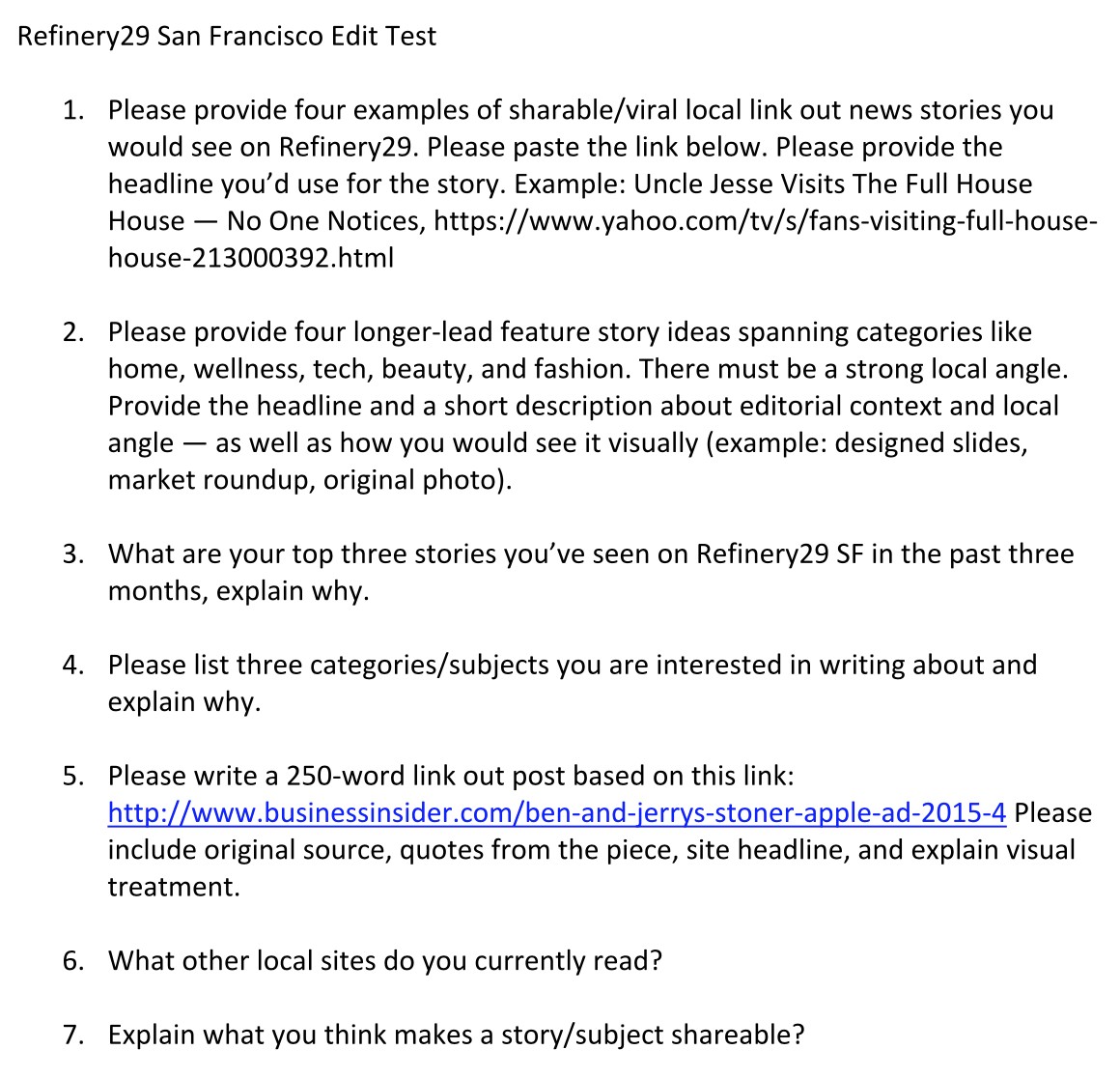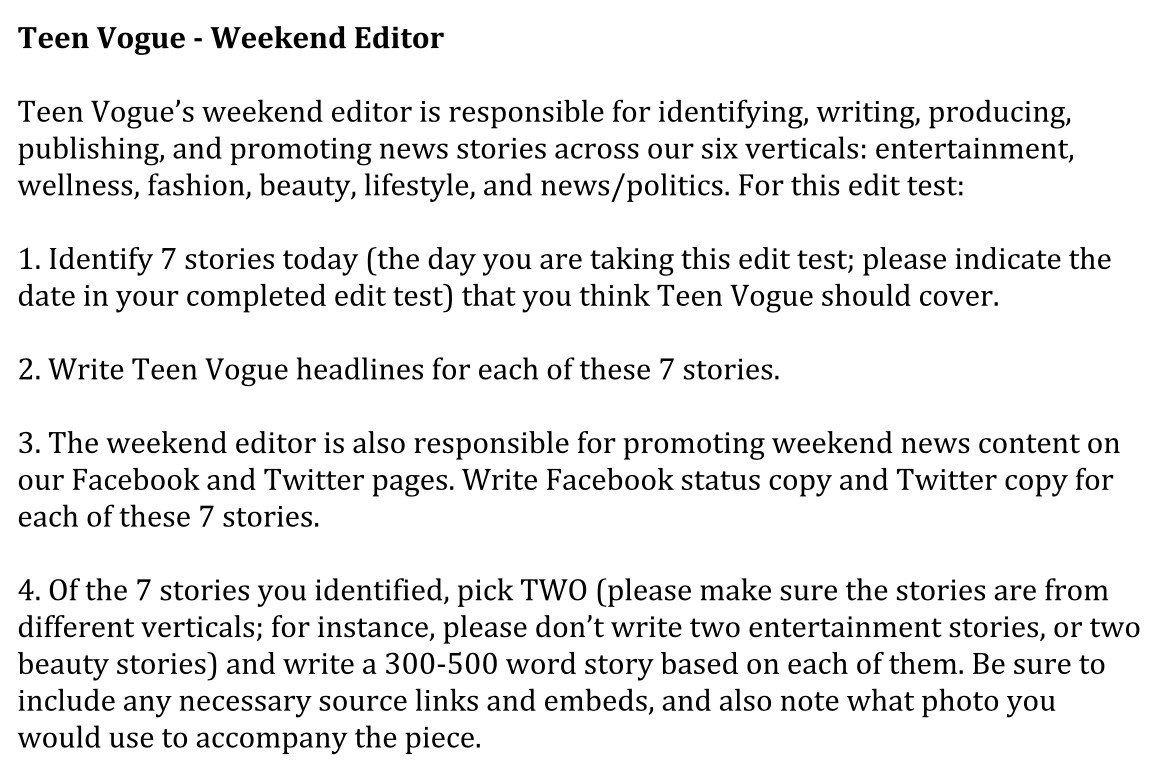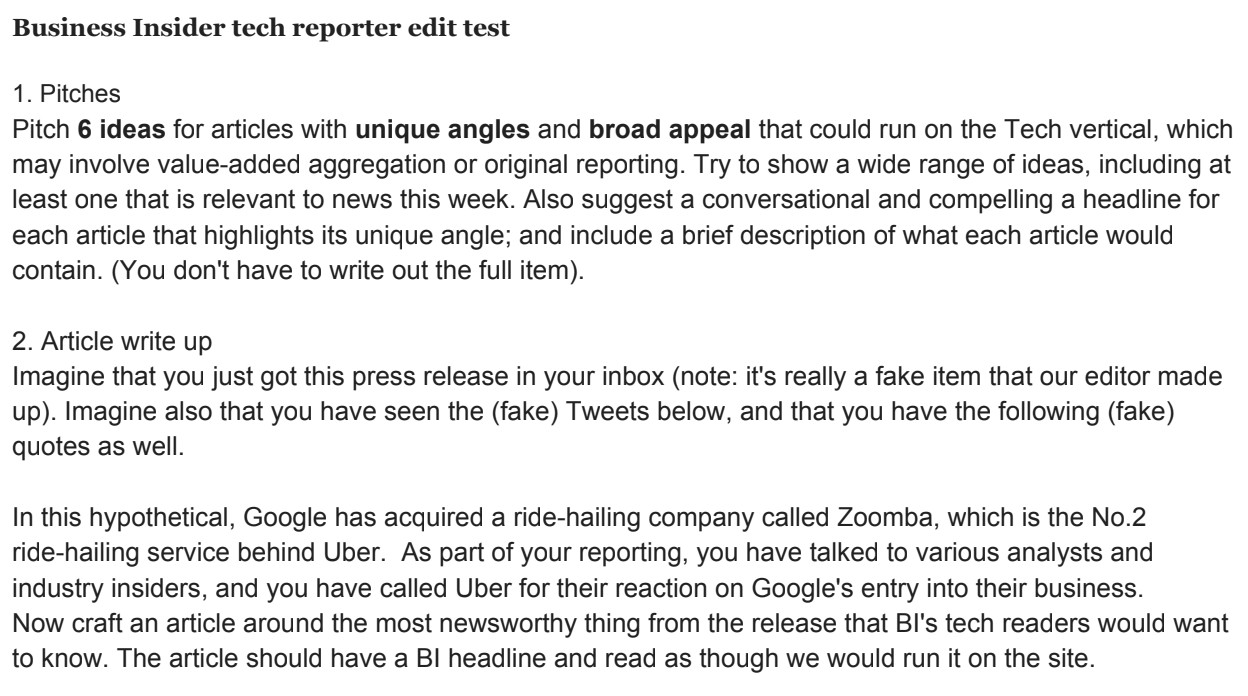Sign up for The Media Today, CJR’s daily newsletter.
In the spring of 2015, GQ asked freelance writer and editor Beejoli Shah to produce a four-page front-of-book section for the magazine. She was responsible for conceiving every element, from lists to profiles to Q&As, and naming writers she thought would be right to tackle each piece. She had two days to do it, although it usually takes editors several weeks. And she would not be paid.
Shah didn’t work at GQ, although she hoped to. The FOB she made wasn’t real: It was an edit test, the screening exercise nearly every publication requires candidates to complete at some point in the hiring process. Shah, an experienced journalist, knew a test was inevitable when she applied for the senior-level Culture Editor position, so she devoted 36 hours to writing 900 words of FOB ideas, plus 3,000 more addressing the other three portions of the edit test. “It was a nightmare, but I wanted that job so badly,” she says.
TRENDING: How hacked emails and a yacht in Monaco ended my career at WSJ
After returning the test, she met briefly with another editor, which felt promising. A month later, he told her the magazine was “unclear” about their plans. That was the last she heard about the position. “I get that there are a million people taking the test, but to me, that shows how little the hiring process is valued,” she says. “I don’t think people realize how much work is being asked.”
Reached for comment, GQ Editorial Director Sarah Ball says the magazine’s tests have “evolved significantly” over the past three years to become more digitally focused, and that every editor who administers tests “certainly tries to respond to each candidate.” With regard to Shah’s experience, Ball says, “We very much regret if a candidate felt they didn’t receive sufficient feedback in the past—and we’ll take steps to ensure this doesn’t happen again.”
Job searches in any field often feel like taking on a second, unpaid job in addition to your current one. But for journalists, that second job has a second job of its own, and the disappearance of available full-time positions means doing more of it than ever before. Interviews with more than two dozen writers and editors reveal that, as journalism jobs have evaporated, edit testing has become excessively burdensome for candidates. These journalists find themselves taking on multiple tests a year, sometimes simultaneously, amounting to 20 or more unpaid hours of work per test that often yield no results—in many cases, like Shah’s, not even a note informing them they’re no longer being considered.
ICYMI: A portrait of Trump’s mental state by photojournalists
“The intensity of some edit tests can make you forget who you are and whether you’re good at anything,” says Kenzi Wilbur, a freelancer who has both taken and, as a staff editor, administered edit tests. “You’re left peeling yourself off the floor with no brain. Those kill-yourself ones, where it’s 40 or 60 hours of work, seem to be created in a vacuum where the recipient has no life.”
Job searches in any field often feel like taking on a second, unpaid job in addition to your current one. But for journalists, that second job has a second job of its own.
As with many aspects of the work of journalism, things were different in the days of print. When Columbia journalism professor and CJR contributor Merrill Perlman applied for a copy editor position at The New York Times in 1983, the paper flew her to New York to work for a week alongside the copy editors, paying her a salary for the duration of her stay. Craig Gaines, who is currently copy chief at The Ringer, had a similar experience with a small newspaper where he worked early in his career. Tests like these sought to determine, as Perlman says, “not only whether you can fix bad copy, but whether you know to leave good copy alone.” They were not bundled with idea generation like what GQ asked of Shah.
RELATED: The most annoying thing an editor can do
Perlman went on to have a 25-year career at the Times copy desk, during which a combination of expanding staff and tightening budgets ended paid edit tests. By the time she departed the paper in 2008, the Times had added take-home tests to its hiring arsenal, to screen candidates before bringing them to New York for the next round. “It was not as rigorous, and it was not supposed to be a huge investment of time, so we didn’t compensate [candidates for take-home tests],” she says. Tests had also begun to incorporate Web headlines, SEO, and other skills required of post-internet journalists: Save for handful of positions solely for print work, editors had also become content creators, search-optimization wizards, and social media copywriters.
So it would make sense that edit tests should similarly evolve to examine a broader palette of skills. But according to journalists who have been working in the industry for under 10 years, testing has passed the point of rigor and entered the realm of the ridiculous. “Editors seem to hand them out like candy,” says one freelancer of six years who, like most of the sources in this piece, feared being blacklisted from future jobs and requested anonymity.
Even the phrase “edit test” has itself taken on more meaning, growing to include writers as well as editors. For the former, an “edit test” is really a writing test on how fast the candidate can compose a story, and how ready for publication it will be when turned in. Perhaps because many of today’s hiring editors came up in the high-volume atmosphere of early-aughts blogs, these positions, and their edit tests, are similarly pressure-fueled. That’s the case with an 2015 edit test for The New Republic, excerpted below. The freelancer who provided it was working on another test simultaneously; when she learned that TNR’s (which had a three-day turnaround requirement) included time-stamping for when she filed, which she found “particularly crazy,” she politely declined to move forward with the application. Reached for comment, The New Republic had not responded by time of publication.
Excerpt: TNR National News Editor Test
- Please write three short posts (400 words maximum) on separate news stories that have broken in the last 12 hours (include a timestamp when you complete each item). While these posts should be timely, they should also be in The New Republic’s voice, not a news wire’s. Please include one headline for each item, though additional alternatives are appreciated. Rather than aggregate the news, find a fresh perspective on it. Don’t shy away from opinion, but it’s not required either. We’re most interested in the creativity of your approach, and in your writing voice.
- In addition, come up with three story ideas that could be assigned to a New Republic staffer based on news events that have occurred in the last 12 hours. Since these pieces are meant to be timely, a writer should be able to complete each idea within a few hours of receiving it. Please describe exactly what the angle would be.
(To be clear: The three posts and three story ideas should be about news that broke within 12 hours of when you email the completed test to me.)
That test was not paid, although other, less demanding tests I reviewed were. One writer received “about $30/hr” for a trial run as a weekend editor at Esquire.com and $100 for a day at the Times’s Wirecutter vertical, pay that she felt “was fair.” Another was paid $250 for a one-day trial as a staff writer at The Outline. Bustle paid one candidate $17/hr for a six-hour trial shift, although she had to first complete an unpaid test that included pitching three story ideas about that day’s news within only a few hours. She says she thought those requirements were barely reasonable. “There’s this notion in the industry of, Well, I had to do this back in my day, so deal with it, instead of thinking about new ways to hire reporters and writers,” she says. Reached for comment, Esquire and The Outline both declined, and at the time of publication, neither the Wirecutter nor Bustle had responded.
For editing candidates, testing is a hulking package of work that includes not just fixing stories but writing a memo pitching anywhere from five to 25 ideas, as well as critiquing some or all of the publication at hand. While these memos have long been standard practice for hiring an assigning editor tasked with overseeing a section and other editors, the steps were often administered separately. Will Bourne, an editorial strategist who has held top editing positions at Fast Company, Audubon, and The Village Voice (where I worked for him in 2016), says he would usually assign an edit memo first, then an editing test to the most promising candidates. “I can’t even tell you the number of times I’ve been surprised at how badly someone did on an edit test and saved myself a terrible hire,” he says.
Unless and until the current unionization wave really starts to bear fruit, if ever, you will talk yourself out of a job if you fight to get paid to take an edit test. There’s too much hunger out there.”
But because editing tests are always comprised of stories that have either been run previously or killed, along with ideas the editor isn’t actually writing, a publication can’t use what a candidate produces the way it can use what comes out of a writing candidate’s test. So there is little justification or incentive to compensate such candidates for their time, even though it used to be standard practice. Bourne acknowledges that this is a legacy of “the roots of magazine jobs as being the purview of rich white kids who can afford to work for free to prove themselves,” but adds, “unless and until the current unionization wave really starts to bear fruit, if ever, you will talk yourself out of a job if you fight to get paid to take an edit test. There’s too much hunger out there.”
ICYMI: Headlines editors probably wish they could take back
People who have taken editing tests also concede that asking for payment might sound ridiculous. But, they countered, so does asking someone to do many hours of unpaid work only to ignore them when it’s finished. Established candidates who have grown to expect this treatment say it affects the quality of their application. “If [the test] comes after the first informational phone call, I have no idea where in the standing I am, and I’m less comfortable putting in all this work,” says Jaya Saxena, a freelancer who has taken a dozen edit tests over almost 10 years in journalism. Being unsure of how seriously a publication is taking you, she says, “might lead to a candidate not showing their best self.”
It can also eliminate strong candidates who simply cannot waste time if it’s unlikely to pay off. “Editors need to consider that people aren’t unemployed, that they might be parents,” says Natalie Pattillo, a freelancer who has worked in journalism for seven years as a single parent (an experience she recently wrote about for CJR). “I’ve sometimes had to get a babysitter [so I could] do an edit test. Luckily, they were friends, but if I didn’t have that network I’d have to pay someone for half a day every time I took one.” Pattillo has taken four edit tests in the past year; one of them, for Bustle, required pitching between 30 to 35 story ideas, writing pieces from two of those ideas, and editing 2,600 words of raw copy spread across three stories. It was too much, and she withdrew her application.
Excerpt: Bustle Associate Lifestyle Editor Test
- Covering Sex & Relationships News/Trending Stories
The associate lifestyle editor will be responsible for covering sex and relationships news and trending stories…This means approaching news and trending stories, whether it’s a study on the state of sex ed in America or the latest dating term everyone’s talking about, through a lifestyle lens and assigning new, thought-provoking angles that are both search-friendly and social-friendly. Please pick 10 sex and relationships stories dominating the news this past week, and for each brainstorm one search headline you could potentially see Bustle’s lifestyle vertical covering (think things you would Google), and one social headline (something that you think would perform well on Facebook). For each idea, please include at least 2-3 sentences about the story and the unique angle you’d take, and any relevant links. - Sex & Relationships News/Trending Write-Ups
Choose two of your ideas from #1, and turn them into complete stories around 600-800 words. Please be sure we haven’t done this story before. - Evergreen Pinterest Stories
Please pitch 20-25 sex & relationships, health, and mental health service angles that would appear on Bustle’s Pinterest. Include a sample headline and at least 2-3 sentences about the story. - Editing Sex & Relationships Stories
Below, you’ll find three examples of stories the associate lifestyle editor would likely be responsible for editing — one trending news story and two evergreen stories. Please edit for tone, voice, sensitivity, and accuracy. Please also include any notes pointing to where you think the writer could have included more information, used an expert, or expanded for clarity.
The particular irony of self-described feminist websites like Bustle requiring hours of unpaid work from young women is not lost on any of these candidates. It’s also not lost on Koa Beck, the editor in chief of Jezebel, who several people praised as one of few editors who seemed sympathetic to the concerns of the edit-tested. “I do not like the precedent of asking young women, green journalists, to hand over all their ideas for free to a stranger,” she says. “I’m very clear with my candidates that if I’m not hiring them, I am not taking their ideas. No one in my own career ever explicitly said that to me, and I wish they had.”
This possibility—of having ideas stolen from an edit test—rivals the excessive workload as journalists’ main concern about what they’re agreeing to as part of a job application. It hasn’t happened to anyone I spoke with, but everyone mentioned it. Forking over your best ideas for a memo that disappears into an HR void is nearly as unsettling as pure theft—particularly for freelancers, whose income depends on pitching continuously. “When you don’t hear back after submitting those ideas, those are the points where the paranoia sets in,” Saxena says. “I just sent you three pitches and signed no contract about what you’re allowed to do with those, and I feel like I have to wait until I hear about the job to shop those elsewhere.”
I do not like the precedent of asking young women, green journalists, to hand over all their ideas for free to a stranger.”
No one thinks it possible, let alone wise, to do away with edit testing entirely: All of journalism happens before publication, so of course a hiring committee can’t go off clips or a résumé. Both writers and editors understand from experience that it’s impossible to know if a writer can strike just the right tone for a publication, or if an editor can make copy sparkle in just the right way, without asking them to prove it first. And it can even be helpful for candidates; as one writer told me, “taking edit tests is when I know whether I want the job: I sit down and either really love the work or I really can’t get excited about it, and that tells me something.”
But if publications want stellar applications from phenomenal candidates, they need to rethink when, how, and why they’re administering edit tests. The baseline: Only administer an edit test if you’re legitimately interested in a candidate. “If you’re handing them out as a first step to almost everyone who applies, there’s no way you’re reviewing any of them thoughtfully,” says one editor. Many people I spoke with suggested breaking tests up into steps, each of which would cull a certain number of candidates. Or, if that’s too much work, saving the test until the last possible step. And maybe—just maybe—consider putting some skin in the game.
“If GQ and California Sunday and Wired are all chasing ASMEs, why are they not putting a couple grand into their hiring process?” wonders Shah, who has taken edit tests at all three publications. “To only bring in five people for edit tests and give them each $200? That’s only $1,000. That doesn’t seem like a lot.”
More editing test excerpts
ICYMI: There are three kinds of journalists. Which one are you?
Has America ever needed a media defender more than now? Help us by joining CJR today.







